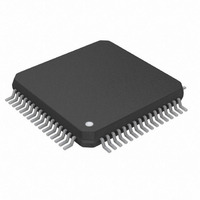DS26521LN+ Maxim Integrated Products, DS26521LN+ Datasheet - Page 21

DS26521LN+
Manufacturer Part Number
DS26521LN+
Description
IC TXRX T1/E1/J1 64-LQFP
Manufacturer
Maxim Integrated Products
Type
Line Interface Units (LIUs)r
Datasheet
1.DS26521LN.pdf
(258 pages)
Specifications of DS26521LN+
Number Of Drivers/receivers
1/1
Protocol
T1/E1/J1
Voltage - Supply
3.135 V ~ 3.465 V
Mounting Type
Surface Mount
Package / Case
64-LQFP
Lead Free Status / RoHS Status
Lead free / RoHS Compliant
- Current page: 21 of 258
- Download datasheet (2Mb)
RSYSCLK
RMSYNC/
RFSYNC
RSYNC
RSIGF/
NAME
RSER
RCLK
FLOS
RSIG
RLF/
LTC
AL/
PIN
57
56
55
54
53
52
51
50
TYPE
I/O
O
O
O
O
O
O
I
Received Serial Data. Received NRZ serial data. Updated on rising edges of
RCLK when the receive-side elastic store is disabled. Updated on the rising edges
of RSYSCLK when the receive-side elastic store is enabled. When IBO mode is
used, the RSER data is synchronous to to RSYSCLK. This is described in Section
8.8.2.
Receive Clock. A 1.544MHz (T1) or 2.048MHz (E1) clock that is used to clock
data through the receive-side framer. This clock is recovered from the signal at
RTIP and RRING. RSER data is output on the rising edge of RCLK. RCLK is used
to output RSER when the elastic store is not enabled or IBO is not used. When the
elastic store is enabled or IBO is used, the RSER is clocked by RSYSCLK.
Receive System Clock. 1.544MHz, 2.048MHz, 4.096MHz, 8.192MHz, or
16.384MHz receive backplane clock. Only used when the receive-side elastic store
function is enabled. Should be tied low in applications that do not use the receive-
side elastic store. Multiple of 2.048MHz is expected when the IBO mode is used.
Receive Synchronization. If the receive-side elastic store is enabled, then this
signal is used to input a frame or multiframe boundary pulse. If set to output frame
boundaries, then RSYNC can be programmed to output double-wide pulses on
signaling frames in T1 mode. In E1 mode, RSYNC out can be used to indicate
CAS and CRC-4 multiframe. The DS26521 can accept H.100-compatible
synchronization signal. The default direction of this pin at power-up is input, as
determined by the RSIO control bit in the RIOCR.2 register.
Receive Multiframe/Frame Synchronization. A dual function pin to indicate
frame or multiframe synchronization. RFSYNC is an extracted 8kHz pulse, one
RCLK wide that identifies frame boundaries. RMSYNC is an extracted pulse, one
RCLK wide (elastic store disabled) or one RSYSCLK wide (elastic store enabled),
that identifies multiframe boundaries. When the receive elastic store is enabled,
the RMSYNC signal indicates the multiframe sync on the system (backplane) side
of the elastic store. In E1 mode, this pin can indicate either the CRC-4 or CAS
multiframe as determined by the RSMS2 control bit in the Receive I/O
Configuration register (RIOCR.1).
Receive Signaling. Outputs signaling bits in a PCM format. Updated on rising
edges of RCLK when the receive-side elastic store is disabled. Updated on the
rising edges of RSYSCLK when the receive-side elastic store is enabled.
Analog Loss/Receive-Signaling Freeze/Framer LOS. Analog LOS reflects the
LOS (loss of signal) detected by the LIU front-end and framer LOS is LOS
detection by the corresponding framer; the same pins can reflect receive-signaling
freeze indications. This selection can be made by settings in the Global
Transceiver Clock Control register
If framer LOS is selected, this pin can be programmed to toggle high when the
framer detects an LOS condition, or when the signaling data is frozen via either
automatic or manual intervention. The indication is used to alert downstream
equipment of the condition.
Receive Loss of Frame/Loss of Transmit Clock. This pin can be programmed to
either toggle high when the synchronizer is searching for the frame and multiframe,
or to toggle high if the TCLK pin has not been toggled for approximately three clock
periods.
RECEIVE FRAMER
21 of 258
(GTCCR
FUNCTION
DS26521 Single T1/E1/J1 Transceiver
).
Related parts for DS26521LN+
Image
Part Number
Description
Manufacturer
Datasheet
Request
R

Part Number:
Description:
Ds26521 Single T1/e1/j1 Transceiver
Manufacturer:
Maxim Integrated Products, Inc.
Datasheet:

Part Number:
Description:
power light source LUXEON® Collimator
Manufacturer:
LUMILEDS [Lumileds Lighting Company]
Datasheet:

Part Number:
Description:
MAX7528KCWPMaxim Integrated Products [CMOS Dual 8-Bit Buffered Multiplying DACs]
Manufacturer:
Maxim Integrated Products
Datasheet:

Part Number:
Description:
Single +5V, fully integrated, 1.25Gbps laser diode driver.
Manufacturer:
Maxim Integrated Products
Datasheet:

Part Number:
Description:
Single +5V, fully integrated, 155Mbps laser diode driver.
Manufacturer:
Maxim Integrated Products
Datasheet:

Part Number:
Description:
VRD11/VRD10, K8 Rev F 2/3/4-Phase PWM Controllers with Integrated Dual MOSFET Drivers
Manufacturer:
Maxim Integrated Products
Datasheet:

Part Number:
Description:
Highly Integrated Level 2 SMBus Battery Chargers
Manufacturer:
Maxim Integrated Products
Datasheet:

Part Number:
Description:
Current Monitor and Accumulator with Integrated Sense Resistor; ; Temperature Range: -40°C to +85°C
Manufacturer:
Maxim Integrated Products

Part Number:
Description:
TSSOP 14/A°/RS-485 Transceivers with Integrated 100O/120O Termination Resis
Manufacturer:
Maxim Integrated Products

Part Number:
Description:
TSSOP 14/A°/RS-485 Transceivers with Integrated 100O/120O Termination Resis
Manufacturer:
Maxim Integrated Products

Part Number:
Description:
QFN 16/A°/AC-DC and DC-DC Peak-Current-Mode Converters with Integrated Step
Manufacturer:
Maxim Integrated Products

Part Number:
Description:
TDFN/A/65V, 1A, 600KHZ, SYNCHRONOUS STEP-DOWN REGULATOR WITH INTEGRATED SWI
Manufacturer:
Maxim Integrated Products

Part Number:
Description:
Integrated Temperature Controller f
Manufacturer:
Maxim Integrated Products

Part Number:
Description:
SOT23-6/I°/45MHz to 650MHz, Integrated IF VCOs with Differential Output
Manufacturer:
Maxim Integrated Products










